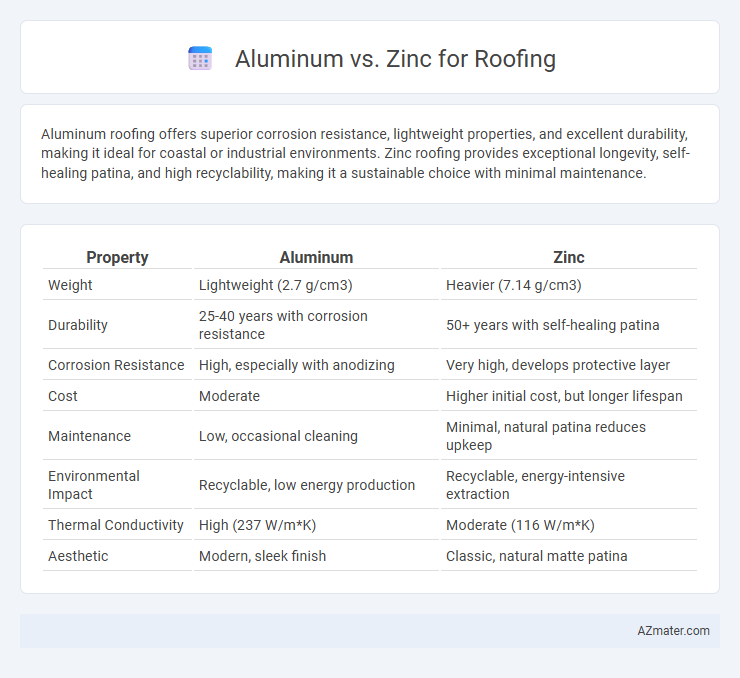Aluminum roofing offers superior corrosion resistance, lightweight properties, and excellent durability, making it ideal for coastal or industrial environments. Zinc roofing provides exceptional longevity, self-healing patina, and high recyclability, making it a sustainable choice with minimal maintenance.
Table of Comparison
| Property | Aluminum | Zinc |
|---|---|---|
| Weight | Lightweight (2.7 g/cm3) | Heavier (7.14 g/cm3) |
| Durability | 25-40 years with corrosion resistance | 50+ years with self-healing patina |
| Corrosion Resistance | High, especially with anodizing | Very high, develops protective layer |
| Cost | Moderate | Higher initial cost, but longer lifespan |
| Maintenance | Low, occasional cleaning | Minimal, natural patina reduces upkeep |
| Environmental Impact | Recyclable, low energy production | Recyclable, energy-intensive extraction |
| Thermal Conductivity | High (237 W/m*K) | Moderate (116 W/m*K) |
| Aesthetic | Modern, sleek finish | Classic, natural matte patina |
Introduction to Aluminum and Zinc Roofing
Aluminum roofing offers exceptional corrosion resistance and lightweight durability, making it ideal for coastal and industrial environments. Zinc roofing is renowned for its self-healing properties and longevity, often lasting over a century with minimal maintenance. Both metals provide energy efficiency and aesthetic versatility, but their distinct physical characteristics influence installation and overall performance in varying climates.
Material Composition and Properties
Aluminum roofing offers lightweight durability with a density of about 2.7 g/cm3, making it resistant to corrosion and ideal for coastal environments due to its oxide layer that prevents rust. Zinc, with a density of approximately 7.14 g/cm3, provides exceptional longevity and self-healing properties as its surface develops a protective patina that guards against weathering. Both metals have high malleability and excellent resistance to environmental damage, but aluminum's lower weight and superior corrosion resistance make it preferable for structures requiring less load-bearing capacity.
Durability and Longevity Comparison
Aluminum roofing offers exceptional durability due to its resistance to rust and corrosion, making it ideal for coastal and humid environments. Zinc roofing provides impressive longevity, often lasting over 80 years, thanks to its self-healing oxide layer that protects against scratches and weathering. Both metals withstand extreme weather conditions, but zinc's ability to develop a protective patina over time often results in longer-lasting performance and reduced maintenance.
Climate Suitability: Aluminum vs Zinc
Aluminum roofing excels in coastal and humid climates due to its superior resistance to corrosion and saltwater damage, making it ideal for seaside properties. Zinc roofing performs exceptionally well in temperate and industrial areas because of its natural patina that protects against pollution and acid rain. Both metals offer durability, but aluminum suits moist environments while zinc is better in variable and acidic conditions.
Corrosion and Rust Resistance
Aluminum roofing offers superior corrosion and rust resistance due to its natural oxide layer that protects the metal from moisture and environmental elements. Zinc roofing also provides excellent corrosion resistance through a self-healing patina that forms when exposed to air and moisture, effectively preventing rust. Both metals are durable for roofing applications, but aluminum is often preferred in marine or highly acidic environments due to its higher resistance to corrosion.
Aesthetic Appeal and Design Flexibility
Aluminum roofing offers a sleek, modern aesthetic with a wide range of customizable finishes and colors that resist fading and corrosion, enhancing long-term visual appeal. Zinc roofing provides a natural, patina-rich surface that evolves over time, offering a unique, classic look favored in traditional and high-end architectural designs. Both metals allow for diverse design flexibility, but aluminum's lightweight properties enable more intricate shapes and faster installation compared to zinc.
Cost Analysis: Initial and Long-Term
Aluminum roofing generally has a higher initial cost compared to zinc but offers greater resistance to corrosion, reducing maintenance expenses over time. Zinc roofing, while cheaper upfront, may incur higher long-term costs due to potential repairs and shorter lifespan in certain environments. Evaluating total lifecycle costs reveals aluminum as a cost-effective option for durability and minimal upkeep in roofing applications.
Sustainability and Environmental Impact
Aluminum roofing offers superior sustainability due to its high recyclability rate, often made from at least 90% recycled content, which reduces the demand for virgin materials and lowers energy consumption during production. Zinc is also eco-friendly with a long lifespan of up to 100 years, minimal maintenance requirements, and the ability to naturally develop a protective patina that reduces the need for coatings or treatments. Both metals contribute to reducing environmental impact through durability and recyclability, but aluminum's lighter weight translates to lower transportation emissions and easier installation, enhancing its green credentials.
Installation Process and Maintenance Needs
Aluminum roofing panels are lightweight, corrosion-resistant, and easy to install with interlocking designs that reduce labor time compared to zinc, which is heavier and often requires specialized handling and skilled labor for proper installation. While aluminum needs minimal maintenance due to its natural oxide layer that prevents rust, zinc roofs develop a protective patina over time, reducing maintenance but requiring periodic inspections to address potential chalking or staining. Both metals offer durability, but aluminum's straightforward installation and low upkeep make it preferable for faster projects, whereas zinc suits long-term roofing with gradual aging characteristics.
Choosing the Right Metal Roofing for Your Project
Aluminum roofing offers superior resistance to rust and corrosion, making it ideal for coastal or humid environments, while zinc roofing excels in longevity and self-healing properties through patina formation. Choosing the right metal roofing depends on factors such as climate, budget, and desired aesthetic, with aluminum providing a lightweight, low-maintenance solution and zinc offering a durable, environmentally friendly option with a lifespan exceeding 80 years. Consider thermal expansion, recyclability, and installation requirements to ensure optimal performance and sustainability for your roofing project.

Infographic: Aluminum vs Zinc for Roofing
 azmater.com
azmater.com